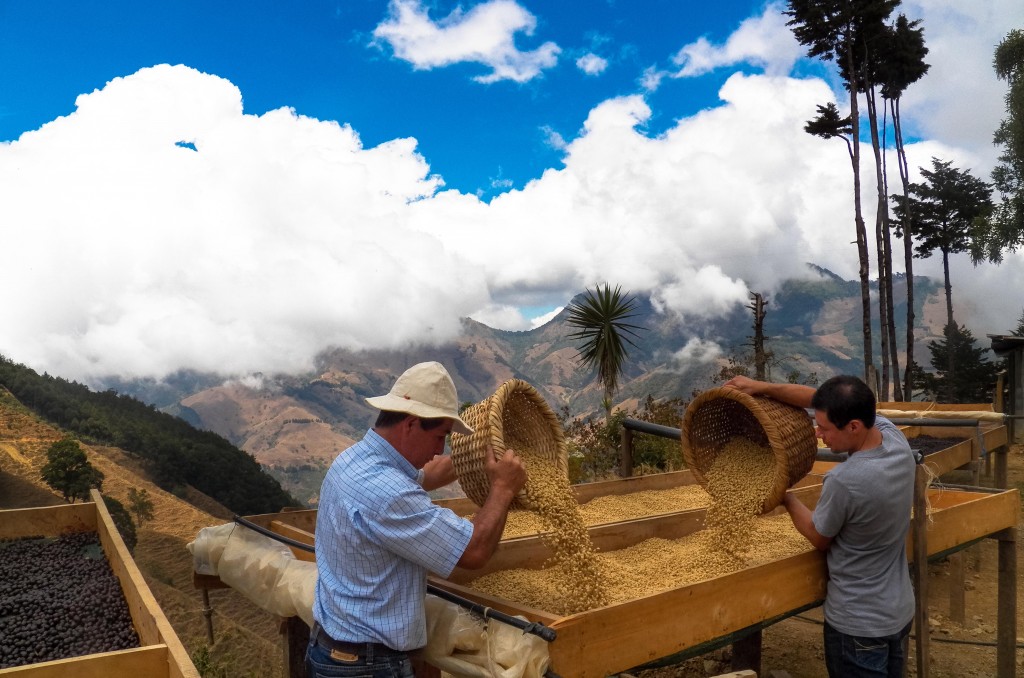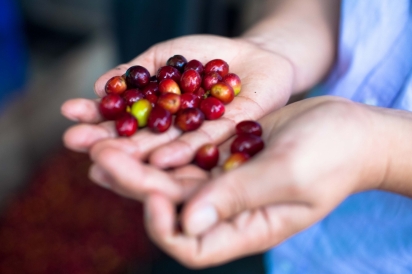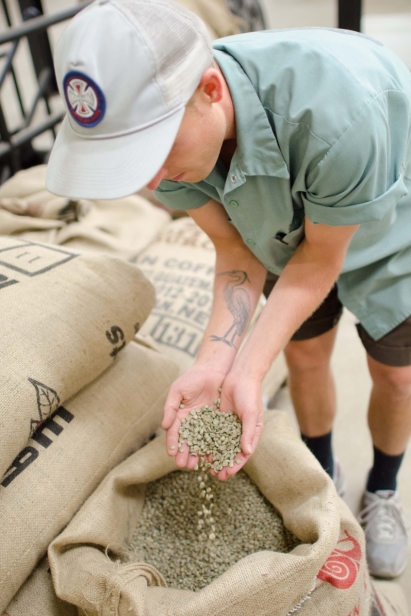On the Coffee Trail
Local coffee buyers seek and taste beans from across the globe
When you take a sip of coffee, you taste more than roasted beans. You taste the time, energy, and passion of the men and women behind that cup. The coffee a barista serves may be the product of a farmer with generations of familial knowledge, a picker’s deft fingers, a buyer’s keen eye, a roaster’s experienced nose. Whatever the factors, that coffee in your hands didn’t have an easy time making it to you, especially if it’s good.
“Finding the quality we want in coffee is hard,” says Matt McClutchy, owner of Anodyne Coffee Roasting Company. “Financing that is difficult as well because once we find something we like it’ll be six months (until arrival). We pay for it six months before the customers do.” The discipline imposed by this extended buying cycle reflects a commitment to quality—all to satisfy the thirst their customers have for good coffee.
So where does any java begin? As a plant growing in tropical countries from Costa Rica to Sri Lanka. Each cup starts as rows of leafy green shrubs weighed down by thin branches chock full of tiny, berry-looking orbs that vary in color from a light pistachio green to a deep oxblood red.
Before being picked and washed, coffee beans lie encased in a fruit layer called a coffee cherry (those berry things). When the coffee cherry turns red, it’s ready to be harvested. While there are different ways to pick the fruit, the highest quality coffee comes from pickers and sorters who carefully comb through the plants by hand, only harvesting the ripest fruits. Farmers will then remove the fruit completely, partially, or not at all. Each method changes the end flavor of the coffee. This process, along with the region and climate of origin, might give you an idea of the staggering range of coffee taste profiles. After drying the beans in the sun for multiple days, farmers remove any excess skin from the bean. Et voilà: “green coffee.”
“You can compost the coffee skins that are washed off,” says Christian Ott, the Director of Coffee for Stone Creek Coffee. “Almost all farms do it. Some farms also make cascara, a tea made from dried coffee skins.”
The rock-hard beans are then shipped to buyers at American coffee companies, where they hold a tasting called “cupping” to check the quality. Most receive dozens of green coffee samples to cup every year. It’s after this sampling that buyers narrow down which beans and what taste they’ll target with their blends. After a business connection is established, many buyers will travel to coffee farms to strengthen relationships, while some prefer to make occasional exploratory trips to sample brews in the presence of farmers.
Values of Buyers
Each coffee company has standards they hold their partners to and vice versa. “We look for three things,” says McClutchy. “Seasonality, quality of the cup, and traceability: being able to trace it back to the farm.”
Building trust is a key ingredient to producing high quality coffee. Farmer-company relationships can evolve into partnerships that last for years or even decades, yielding additional benefits. Perhaps farmers will recommend a blend from a neighboring farm with qualities the company wants, or maybe the company will invest in the producer by financing a health center for employees.
Nathan Hoida, the Coffee Quality Manager for Colectivo, recently returned from a trip to Peru to visit a cooperative called La Prosperidad de Chirinos (the prosperity of Chirinos). Chirinos was founded in 1968 with 35 members, and has grown to 653 active members, Hoida says. “Seeing what they’ve accomplished in terms of infrastructure and social programs within the time we’ve been purchasing coffee from them is extraordinary,” he says.
This past January Ott and his team took a buying trip to Costa Rica and were introduced to a family-run farm called Cerro Verde. On the farm, General Operations Manager Deyner Fallas Mora participates in every step of the harvesting process, even the picking and sorting. This dedication to quality aligns itself perfectly with what many companies are looking for in producers, and resulted in a new partnership between Stone Creek and Cerro Verde.
Buying Coffee Not Just Bean Counting
Such a multi-faceted business is bound to involve countless hurdles. One big challenge for coffee companies around the globe is consistency, especially when dealing with so many different types of blends. It takes a good amount of experience and a great sense of taste in order to find beans that maintain a coffee blend’s profile through multiple seasons, especially when there are so many steps in the coffee producing process. “My co-worker George and I cup around 1,000 samples of green coffee per year, so it’s become second nature to understand the profile required for a blend or a certain coffee to remain consistent and delicious,” Colectivo’s Hoida explains. “The coffees we use for our blends will change seasonally as new crop coffees become available, so we can maintain a high level of freshness and consistency
throughout the year.”
Stone Creek’s Ott says finding a balance between the cost of production and both parties’ needs is tough. “The farms and the company have to have similar interests in sustainability and motives,” he says.
Then there’s the specter of disease. Coffee leaf rust, a crippling fungus, has especially devastated Central American coffee farmers. When leaf rust strikes, buyers have to find new, last-minute sources. Long-term leaf rust infection could also mean termination of buying agreements between buyers and producers, as well as damage to the local coffee economy.
Our local buyers all agree: the heart and soul of coffee is people. Without the farmers who nurture their plants, without the coffee companies who care about quality over quantity, and without those buyers who love their jobs, consistently great-tasting coffee wouldn’t be possible.
“It’s exciting for me when a coffee I haven’t stopped thinking about since cupping at origin arrives in our warehouse,” Colectivo’s Hoida says. “I get to watch it develop at every step—from sourcing to cupping to roasting to serving—and it illustrates the excellence in craft that is required throughout the process.”
Connecting people at opposite ends of the globe is also deeply fulfilling, says Anodyne’s McClutchy. “Harvesting coffee takes time and a ton of work,” he says. “…It’s a satisfying job to bridge the gap between growers and drinkers.”
Photography courtesy of Colectivo and Stone Creek; Photos of Anodyne by Joe Laedtke









